Marketing Attribution: The Secret Sauce to Making True Data-Driven Decisions
Today, marketers rely heavily on multiple channels and all sorts of marketing techniques to engage with customers, carry out marketing campaigns, customize customer’s journeys along each step, and increase clicks, visits, and conversions. While this brings excellent engagement opportunities for marketers, it also poses some unique challenges, such as insufficient internal resources, difficulty in accessing disparate data, limited funding, and a lack of knowledge and support. Marketers also face problems in:
- Analyzing the overall impact of a particular campaign on marketing ROI
- Understanding which engagement tactics, messages, touchpoints, or channels generated leads and drove maximum conversions
- Accurately predicting the impact of increased or decreased spend on these channels
Furthermore, marketers have to wade through cobbled data collated from different sources, spend hours crunching numbers in spreadsheets or wait for a marketing ops resource to help them.
This is when marketing attribution makes the work a lot easier. Marketing attribution is an approach that helps to evaluate various marketing touchpoints a consumer traverses through while making a purchase. It helps marketing teams aggregate consumer data from different marketing channels to achieve the data granularity required to ensure that each interaction is appropriately weighted. This helps in determining which channel or communication had the greatest impact on the decision of customers to take the final step. Let’s look at how marketing attribution adds value to marketers’ complex evaluation process.
Adding Value: How Marketing Attribution Can Aid Your Road Map
1. Deep understanding of customer’s purchase journey: Today, customers utilize various devices, channels, websites, social media apps to browse information and respond to online communications. This makes their purchase journey complex for marketers to understand. Attribution analytics plays a crucial role in understanding which channels and online and offline touchpoints create the most impact during the customer’s journey. This information enables marketers to design more targeted and relevant communication strategies for increased engagement and customer wins.
2. Intelligent marketing decisions: The immediate benefit of marketing attribution is that they help understand the performance and role of each channel or campaign in customer journeys. This not only enables marketers to change the future course of action but also helps them to make intelligent marketing decisions that result in better conversions and engagements. Timely and targeted marketing decisions can have a huge impact on the company’s bottom-line.
3. Get a holistic view of marketing data: Identifying new opportunities and predicting future outcomes through the marketing data collected from various touchpoints, channels, and apps can be daunting. It is important for marketers to gain deeper insights into customers’ behavior, needs, and expectations to make better, informed marketing decisions. Another critical factor to study is how one channel impacts the other. This information arms marketers with the data and figures they need to forecast and optimize future events.
4. Improved customer experience: Marketing attribution not only improves product performance and marketing effectiveness but also enhances customer experience. When a marketer understands customer behavior, preferred touchpoints, expectations, and needs, the marketing strategies become more aligned, relevant, engaging, and specifically targeted. This results in better customer engagement, delight, and brand loyalty.
5. Optimized marketing spends: The most immediate benefit of marketing attribution is that it helps marketers decide which channels are most beneficial for the amount paid. These insights help marketers distribute and allocate marketing budgets for the best-performing channels or touchpoints for better outcomes. Additionally, advanced attribution models can provide accurate numbers and costs associated with each touchpoint and analyze key factors, such as cost per acquisition, cost to serve, customer value, higher quality leads, and more.
Identifying The Ideal Attribution Model for Your Business
While choosing the right marketing attribution model is paramount, there’s no ‘perfect,’ or a ‘one size fits all model’ out there. Each attribution model works by assigning value to marketing campaigns, touchpoints, and channels through statistical analysis at the user level. Deciding on which model will work best for a business depends entirely on its objectives and various other factors, such as sales cycle length, customer journeys, number of touchpoints, the role of brand perception in conversion, the impact of external factors, and more. Companies need to question themselves about what they want to measure. For instance, they would want to know about:
1. Which content is generating more leads?
Content is one of the most effective online marketing methods that help generate leads. Every company and its marketing team would want to know how effectively their specific content pieces, such as blog posts, infographics, and social media posts, perform and contribute to lead generation. Marketing attribution models and reports gather all this data to show the number of times a particular content piece was viewed before the consumer converted into a lead. This information helps marketers understand which content, topics, and formats perform better to make more informed decisions in the future.
2. What marketing channels are best to invest in a company’s marketing resources?
Marketers must determine the contribution of different channels and touchpoints in lead generation. Marketing attribution provides information on which specific marketing channel is generating more leads and where should the marketing team invest its resources. For instance, if a company is prioritizing and investing its resources on social media without any return, whereas a ton of leads are generated from email marketing with little effort, the company needs to take a second look at its priorities.
3. Which web pages are contributing the most in driving conversion?
Apart from content pieces, such as blog posts or infographics, there can be other content on the company’s website contributing to conversions. It can be a company’s homepage, pricing page, about us page, or any other informational page helping in lead generation throughout the marketing funnel. Marketing attribution reports provide a clear picture of how many times these pages have been viewed on your website. This helps in making informed decisions about which pages should be promoted or optimized and which of them are helping to push the audience down the funnel quicker than others.
Once the marketing team is clear about what it wants to measure, it can opt for an attribution model from the following list. Let’s look at different attribution models in-depth and how they work:
Single Source Marketing Attribution
1. First-touch Attribution: First-Touch Attribution refers to the initial point when the customer interacted with a company through advertisement or any other channel and converted thereafter. Therefore, the full attribution credit is given to this first touchpoint, regardless of subsequent additional messaging.
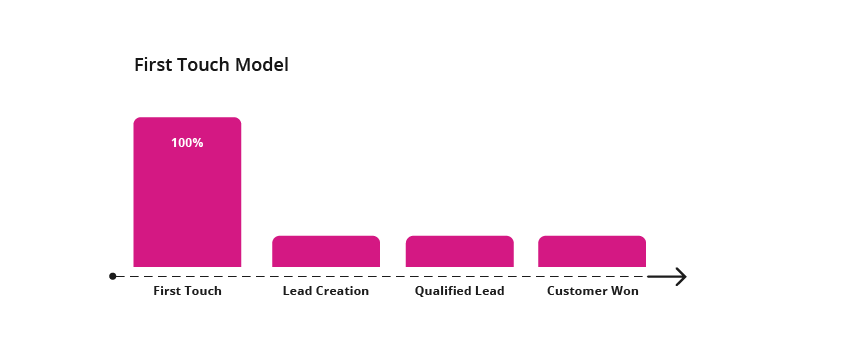
2. Last-touch Attribution: It is just the opposite of the first-touch attribution model. This model gives the full attribution credit to the last touchpoint where the customer converted into a lead. This is the standard attribution model used by many analytics tools, including Google analytics.
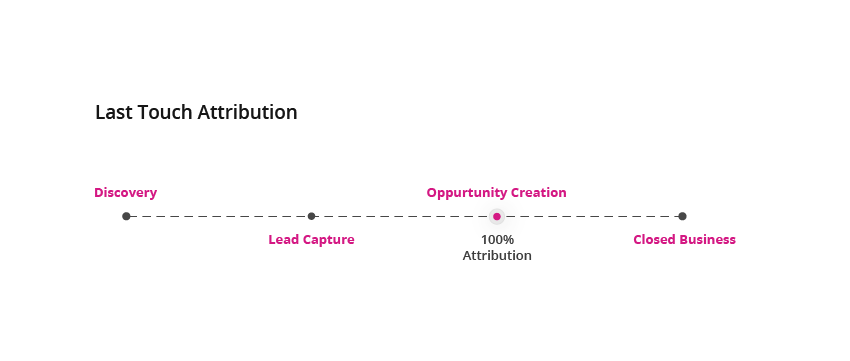
Multi-source Marketing Attribution
1. Linear: Linear attribution model splits the customer conversion credit equally to each touchpoint the customer has traversed until conversion. In short, it weighs each touchpoint or interaction equally that a business has used for marketing.
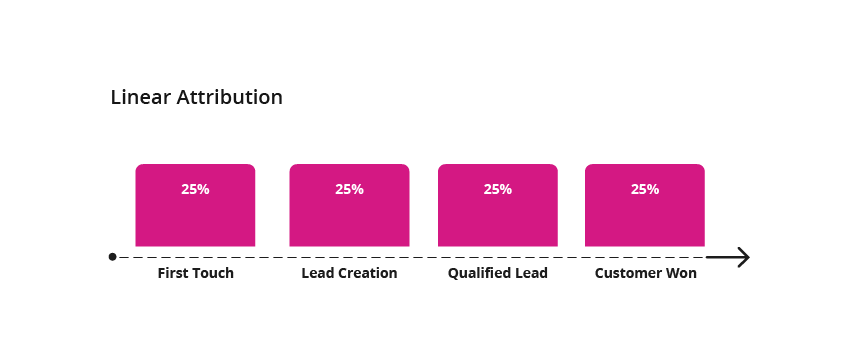
2. U-shaped: The U-shaped attribution model gives credit to all the touchpoints a customer utilizes in the entire purchase journey. However, the maximum credit is given to the first and last touchpoints than those encountered in the middle.
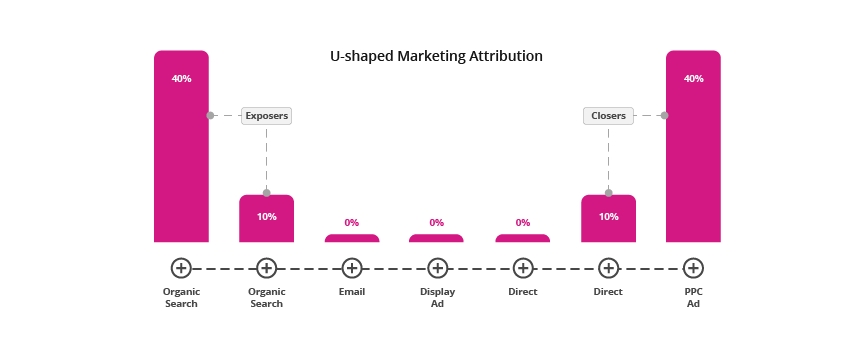
3. Time Decay: This attribution model measures each differently on the path to purchase. It gives maximum credit to the touchpoints closest to the final conversion, assuming that they had a greater impact on the sale.

4. W-shaped: This attribution model is similar to a U-shaped model wherein the first, and last touchpoints get the maximum credit. The only difference is that the W-shaped model also assigns a heavier value to the mid-funnel touchpoint, also known as the opportunity stage. The rest of the touchpoints are credited evenly.
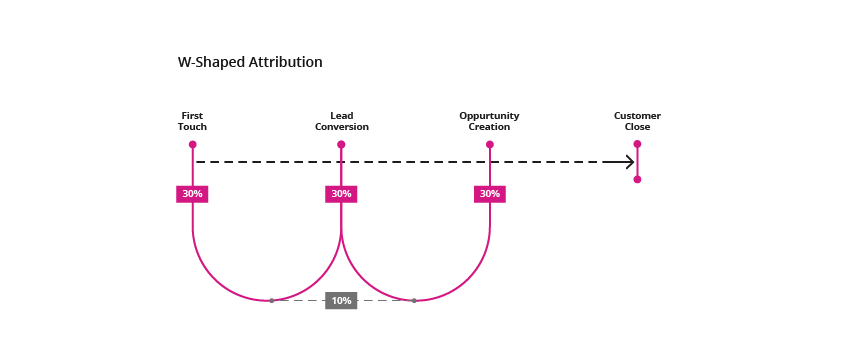
Weighted Multi-source Marketing Attribution
A weighted multi-source attribution model helps acknowledge all the interactions throughout the sales cycle. However, it gives exclusive weightage to the touchpoints that added more value or did the heaviest lifting. Although this model accurately depicts the customers’ journey, it is extremely complex and difficult to apply. It works by assigning a revenue percentage to the array of touchpoints a customer has traversed during the purchase journey.
Omnichannel Attribution: The New Trend
Today, organizations across healthcare, retail, finance, and technology are leveraging omnichannel marketing attribution to understand consumers’ preferred touchpoints and create a consistent brand experience. Omni-channel attribution can be defined as the holistic measurement of the marketing mix (online, offline, paid, owned, or earned). This attribution model measures each marketing element’s role in helping drive the final conversion, including physical (offline stores) and digital channels (websites, social media, branding, and messaging).
How to Implement Attribution Models?
Marketing attribution is a significant challenge for all data-driven teams. Without the right tools and technology, it becomes difficult for teams to attribute conversions to channels. Marketing attribution tools allow marketers to look at their marketing efforts, such as channels, pages, and campaigns that had the greatest impact on leads and revenue. This helps them to make informed decisions about where to invest their time and budget. However, before choosing an attribution model for your organization, you need to conduct appropriate research about the features, affordability, native integrations, and more. Let’s look at some popular marketing attribution tools and how they work.
1. Dreamdata: Dreamdata.io is a B2B attribution model and analytical tool that helps understand B2B attribution content marketing ROI, benchmark growth, predict revenue, and more. The tool is a multitouch, account-based attribution model that provides insights into B2B content marketing initiatives. It enables teams to understand their marketing efforts to make better, informed marketing decisions in the future. It helps build complete B2B customer journeys, gain business-critical attribution insights, and experiment to drive up ROI rapidly.
2. Adobe Analytics: Adobe Analytics has a built-in attribution feature that includes all the functionality, including advanced statistics and machine learning to help you measure and determine your marketing goals. Existing users of Adobe Analytics can take advantage of attribution features anytime.
3. Demandbase: Demandbase is an attribution tool with a robust set of marketing attribution features. Apart from measuring the impact of targeted marketing campaigns, the tool can measure every interaction a lead has with your brand. Demandbase, being an ABM platform, matches your marketing attribution data directly to your accounts to identify the level of engagement with the users. It offers multi touch attribution, journey attribution, custom KPIs and dashboards, account-based visibility, and marketing and sales interactions.
Mistakes to Avoid When Choosing an Attribution Model
1. Sticking to a single attribution model for too long: Priorities often change as the company grows. This means companies must measure their marketing activities from time to time to confirm that they are still using the suitable attribution model. Sticking to one model for too long can alter the results. Therefore, switching to other attribution models is a smart decision to fulfill the company’s objectives and expectations.
2. Not aligning decisions to business objectives: Adopting an attribution model without testing it towards the business objectives is one of the biggest mistakes. Discussing the targets or goals with sales and marketing teams about what they want to achieve using the attribution model can help choose the best-fit. For instance, to measure increasing sales, the objective must be finding out the final touchpoint, whereas if a business wants to improve the customer experience, measuring the contribution of each touchpoint will be helpful.
3. Not experimenting beyond a basic attribution model: Most companies follow the attribution trend. They adopt the attribution models based on what other companies are following or stick to the most popular attribution model. This is one of the most common mistakes businesses make without even realizing whether or not it will help achieve their attribution objectives.
4. Not using enough available data: Another mistake that most businesses make while using an attribution model for the first time is not utilizing the available data in the right direction. Attribution models provide numerous insights about campaigns, best-performing channels, successful touchpoints, marketing strategy, and more. With this data, businesses can learn about their audience, evaluate touchpoints, and optimize attribution models accordingly.
Conclusion
As customers explore new channels and companies adopt advanced marketing technologies, attribution becomes crucial. Marketers need to make several considerations when selecting the most successful marketing attribution model for their organization. However, no single model can deliver comprehensive and accurate marketing attribution measurements across the omnichannel journey. Marketers need to combine models to gain crucial insights and optimize their online and offline campaigns.
One of the best approaches is to opt for marketing attribution tools to gather reliable insights. Powerful analytics platforms or marketing attribution tools generate attribution reports using a combination of different attribution models and pull all the relevant interactions from buyers’ journeys to provide marketers the biggest opportunities for lead conversion.

